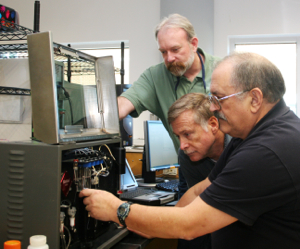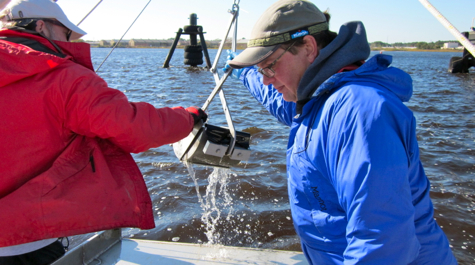NIH grant enables VIMS team to refine biosensor for seafood safety
High-tech tool can be used to assess clean-up efforts in Elizabeth River
Researchers at the Virginia Institute of Marine Science have received a three-year, $872,000 grant from the National Institutes of Health to test whether antibody-based “biosensors” can be used to quickly and accurately predict contaminant levels in shellfish such as oysters.
These new and innovative biosensors will potentially give health officials an important new tool for real-time monitoring of seafood safety in areas contaminated with polycyclic aromatic hydrocarbons. Formed by the incomplete combustion of organic matter, “PAHs” are suspected carcinogens that enter the aquatic environment from the air, petroleum spills, and other sources.
Contamination by PAHs is a major concern in the Elizabeth River, a highly industrialized tributary of lower Chesapeake Bay where several plants once treated marine pilings with a tar-like petroleum derivative called creosote.
 The NIH-funded project—a first for VIMS—is led by VIMS professors Mike Unger, Steve Kaattari, and Wolfgang Vogelbein. It builds on Unger and Kaattari’s earlier breakthroughs in developing biosensors that use the power of the immune system to rapidly detect environmental contaminants at extremely low concentrations.
The NIH-funded project—a first for VIMS—is led by VIMS professors Mike Unger, Steve Kaattari, and Wolfgang Vogelbein. It builds on Unger and Kaattari’s earlier breakthroughs in developing biosensors that use the power of the immune system to rapidly detect environmental contaminants at extremely low concentrations.
The team is partnering in the work with Mr. Joe Rieger, Director of Watershed Planning for the Elizabeth River Project. ERP is a citizens’ group that aims to make the now-contaminated river once again safe for swimming and fishing.
Clean-up of the Elizabeth River’s PAH-contaminated sediments—an effort that also involves Atlantic Wood Industries, the U.S. Environmental Protection Agency, the U.S. Navy, and the Virginia Department of Environmental Quality—is proceeding in two main ways: removal by dredging or capping of the sediments in place.
Unger says the ultimate goal of the remediation is to limit the build-up of contaminants in marine organisms and in people that consume oysters and other seafood. However, he notes that current methods to measure PAH-levels in sediments and oysters are both time-consuming and costly, requiring researchers to return samples to the lab for hours of analysis, with a per-sample cost of up to $1,000. Researchers have tried instead to predict the transfer of PAHs from sediments to oysters using computer models, but with limited success due to the complexity of the process and the number of factors involved.
The biosensor potentially offers a quicker and cheaper solution—previous studies show that it can process samples in less than 10 minutes, detect pollutants at levels as low as just a few parts per billion, and do so at a cost of just pennies per sample. What remains to be seen is whether the biosensor can be used to predict tissue burdens in oysters by sampling PAH-levels in the surrounding environment.
“If we can adapt our biosensor so we can use it in the field to predict what will end up in an oyster, that will be very valuable,” says Unger.
The team will test the biosensor through both field trials and laboratory experiments. The idea behind the field tests, says Unger, “is to use real-time biosensor estimates of PAH levels in the water and sediment pore water to rapidly predict PAH concentrations in shellfish.”
“If we can use biosensor measurements of PAH levels in the water as a surrogate for their concentration in oyster tissues,” he says, “we can monitor large areas over time to determine whether remediation has indeed reduced the load of contaminants that might end up in an oyster.”
Experiments in the new Seawater Research Laboratory at VIMS will help the research team validate the biosensor as a predictor of PAH concentration in oyster tissues. “We’ll complement our field studies with controlled laboratory experiments to test whether aqueous PAH concentrations correlate directly with PAH concentrations in the tissues of dosed oysters,” says Unger. “A strong correlation between the two would validate the use of biosensor for real-time monitoring in the field.”
The research team will also use their NIH funding to test whether they can customize the existing biosensor to recognize the specific PAH molecules that are most readily taken up by living organisms. The goal, says Kaattari, is “to develop additional monoclonal antibodies to better predict the toxic potential of the bioavailable fraction. We’ll attempt to extend the biosensor capabilities by developing a bi- or multi-analyte biosensor that permits simultaneous monitoring of different PAH classes within a single site."



